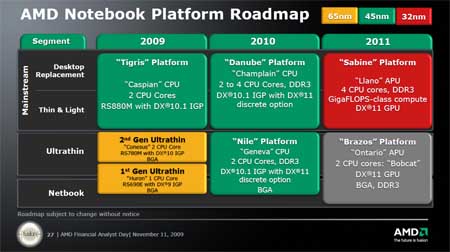AMD updates roadmap, promises "supercomputer in your lap"

AMD's annual analyst's day, which is taking place today, is an opportunity to see how the company's roadmaps for its laptop, desktop and server processors have changed over the past 12 months. This year looked to be especially interesting because AMD recently divorced the design of its products from the manufacturing, now performed by GlobalFoundries, raising questions about the company's ability to deliver on time. AMD sought to put that to rest, stating (repeatedly) that its upcoming chips were ahead of schedule and providing some new details on exactly what these products will offer. (I did not attend this year's analyst day, but AMD provided a live Webcast and the full presentations are available here.)
The most interesting stuff won't arrive until 2011 because that is when AMD will finally introduce notebook and desktop chips that combine multiple CPU cores and graphics on the same physical slice of silicon. AMD refers to these as APUs (Accelerated Processor Units) but the strategy is also known as Fusion, and it's been closely watched because it was part of the justification for the costly ATI acquisition three years ago. But AMD isn't sitting around waiting for 2011. In the past year, the company completed the transition of its processors to 45nm, launched the industry's first 40nm DirectX11 GPUs and introduced a six-core Opteron server processor. Next year AMD plans to release new enthusiast and mainstream laptop and desktop platforms, DX11 notebook GPUs and a 12-core Opteron. These are more evolutionary products than the APUs in 2011, but they should keep AMD competitive. In particular, AMD is promising next year's laptop platforms will deliver at least a 25% improvement in both performance and battery life.
I've long argued that AMD's notebook roadmap has been the company's biggest weakness. Emilio Ghilardi, AMD's Chief Sales Officer, seemed to confirm this when he said that, in his previous role at HP as an AMD customer, his number one question was AMD's notebook lineup. AMD is attempting to address this by focusing on two key segments, mainstream and ultra-thin laptops (UTL), and on improving battery life. In the first half of 2010, AMD will release two new notebook platforms: Danube for mainstream laptops and Nile for UTLs. Danube will include dual- and quad-core Champlain CPUs and a chipset with DX10.1 integrated graphics that will also supports DX11 discrete GPUs. Nile will have a dual-core Geneva CPU and the same graphics. It will replace the Congo platform currently used in products such as the HP Pavilion dm3z. Both new processors will be manufactured using GlobalFoundries' current 45nm processor on SOI (Silicon-on-Insulator) wafers.
In 2011, AMD will introduce its first APU, Llano, which will be part of the Sabine platform for mainstream laptops. Llano will include a quad-core CPU (using the existing Stars cores) and a DX11 GPU capable of "gigaflops-class" performance. Llano will be manufactured using 32nm SOI, which AMD executives said is already working on test chips and will be sampling--the term for giving key customers an early look--sometime next year. The Brazos platform, which will replace Nile, will have an Ontario APU based on a new CPU design known as Bobcat, as well as a DX11 GPU. Bobcat will be capable of operating at less than 1 watt with performance similar to today's mainstream notebooks, AMD officials said. Interestingly AMD execs didn't want to disclose the manufacturing process for Ontario, which at least leaves the door open to leapfrogging Intel and jumping to a 28nm technology--something AMD has been hinting at lately. To be clear, AMD officials didn't say this, but like other semiconductor foundries, GlobalFoundries has both high-performance and low-power 28nm technology on its own roadmap, so it's not hard to connect the dots here.
The desktop roadmap parallels the laptop one with two new platforms each year with the first APUs arriving in 2011. Next year AMD will replace its Dragon enthusiast platform with Leo, which is most notable for its Thuban CPU with up to six cores-basically a desktop version of the shipping Istanbul server chip. The mainstream platform, Dorado, will use AMD Athlon II processors with up to four cores and DX10.1 integrated graphics. Both will be manufactured using the current 45nm SOI technology.
In 2011, AMD will offer an enthusiast platform (Scorpius) with both quad and 8-core Zambezi processors based on a new design, known as Bulldozer. This is not part of an APU--it will use a standard chipset with "next-generation" ATI Radeon graphics. At the mainstream level, AMD will introduce the Llano APU with a quad-core processor as part of its Lynx platform. Both the Zambezi CPU and Llano APU will be manufactured using 32nm SOI technology.
AMD has been on a win streak with its Radeon 4800 series, and most recently Radeon 5000 series GPUs, and the company is hoping it can leverage its graphics expertise to better compete with Intel. With the CPU and GPU on a collision course, AMD execs also talked about "changing the cadence" of its future product releases to more closely match the 12-month GPU product development cycle, rather than AMD's longer CPU schedule of anywhere from 16 to 24 months. If all of this works, Fusion could be the basis for some compelling products. Rick Bergman, the head of AMD's Products Group, promised the technology would "literally deliver a supercomputer on your lap . . . with all-day battery performance." That's an ambitious plan, but it's good to see AMD get some of its mojo back.
